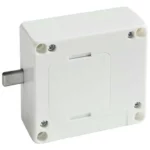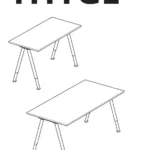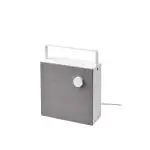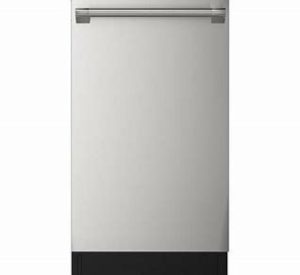
VILLKORLIG Dishwasher Installation Instructions
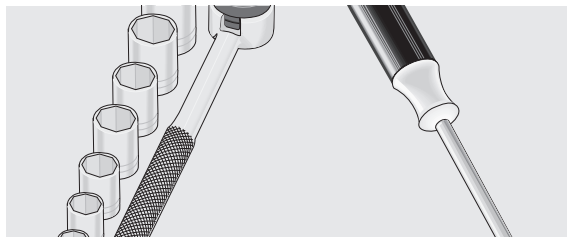
If installing the dishwasher within a cabinet, refer to cabinet installation instructions for cabinet-specific considerations.
INSTALLER: Leave Installation Instructions with owner.
OWNER: Read your dishwasher User Manual. It contains important safety information for operating this appliance. It also has many suggestions for getting the best results from your dishwasher. Keep these instructions with your User Manual manual for future reference. If you have an installation problem, contact your dealer or installer. You are responsible for providing adequate electrical, exhausting and other connecting facilities.
Skill Level: Installation of this dishwasher requires basic mechanical and electrical skills. Proper installation is the responsibility of the installer. Product failure due to improper installation is not covered under the warranty.
Completion Time: 1 to 3 Hours. New installations require more time than replacement installations.
Safety Precautions: The following warnings, cautions, and the important safety instructions do not cover all possible conditions and situations that may occur. It’s your responsibility to use common sense, caution, and care when installing, maintaining, and operating the dishwasher DO NOT attempt to install or operate your unit until you have read the safety precautions in this manual. Safety items throughout this manual are labeled with a Danger, Warning, or Caution based on the risk type.
Definitions


DANGER indicates an imminently hazardous situation which, if not avoided, will result in death or serious injury.

WARNING
WARNING indicates a potentially hazardous situation which, if not avoided, could result in death or serious injury.

CAUTION
CAUTION indicates a potentially hazardous situation which, if not avoided, may result in minor or moderate injury.

IMPORTANT
Indicates installation, operation, or maintenance information which is important but not hazard-related.
Before You Begin

WARNING
Read and observe all CAUTIONS and WARNINGS shown throughout these instructions before installing dishwasher. This guide will help you anticipate drain, water, and electrical connections, and help you select the best location for the dishwasher.
As with all equipment using electricity, water and moving parts, potential hazards exist. To safely operate this appliance, become familiar with its operation and exercise care when using it.

WARNING

ELECTRIC SHOCK HAZARD
Prior to removal of original dishwasher and the installation of your new unit, make sure to switch off your circuit breaker. Do not connect the dishwasher until you have completed the installation. Connecting the power cable is the last step when installing the dishwasher.

WARNING
Install and store the dishwasher inside, away from exposure to weather.
DO NOT install the dishwasher in a location where the water may freeze (where the temperature falls below 32°F (0°C). Frozen water in the hoses, pipes, or other components may damage the dishwasher.

WARNING
TIP OVER HAZARD
- DO NOT use dishwasher until completely installed.
- DO NOT push down or place excessive weight on open door.

WARNING

ELECTRIC SHOCK HAZARD
- Electrically ground the dishwasher.
- Connect the ground wire to the green ground connector in the junction box.
- DO NOT use extension cord.
To reduce the risk of electrical shock, fire, or personal injury, the installer must ensure that the dishwasher is completely enclosed at the time of installation.
Preparing for Installation
Product dimensions
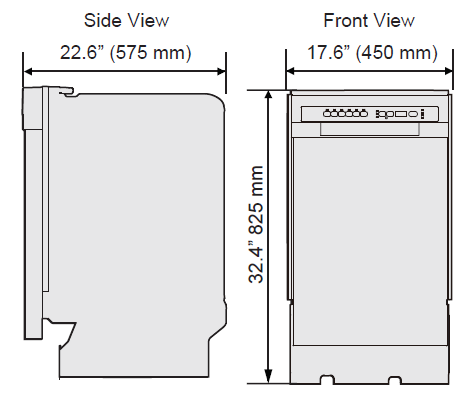

Water supply line, power cable and drain hose will run through the bottom channels from the back to the front connections.
Enclosure dimensions

This dishwasher is designed to be enclosed on the top and on both sides by a standard residential kitchen cabinet unit. The installation enclosure must be clean and free of any obstructions.
The enclosure must be at least 18 inches wide 23 inches deep and 32½ inches high. For the front door of the dishwasher to be flush with the leading edge of the counter top, the counter top must be at least 23 inches deep.
Before starting the installation, prepare all the necessary tools and parts required to install the dishwasher. This will save installation time and simplify the installation process.
Parts Supplied*

- 5*9 screws (x2) for installation bracket
- ST4*14 screws (x2) for installation bracket
- Condensation strip
- Adjustment caps (x2)
- Cable tie for drain hose
- Adjustable toeplate
Parts Needed for Installation (Not supplied)
- Twist on wire connectors (x3)
- Strain relief
- Tape (electrical tape and standard duct tape)
- Hot water supply line
- 90° Elbow
- Tube fittings
- Air gap
- Rubber connector
- Hose clamp
- Power cable(if not able to hard wire)
- PTFE thread seal tape or sealing compound
Tools needed for installation
- Drill and appropriate bits
- Safety glasses
- Gloves
- Flashlight
- Adjustable wrench
- Wire stripper
- Pliers
- Nipper
- Measuring tape
- Pencil
- Phillips screwdriver
- Flat screwdriver
- Tubing cutter
- Utility knife
- Hole saw set
- Level
- Torx® T20 driver
- Hex L-wrench set
* Provided with the dishwasher. Check that all parts are present when unpacking the dishwasher.

DO NOT use plastic tubing. Plastic tubing can deteriorate over time and cause a leak inside the tube fitting.
Copper tubing with a compression fitting or a flexible stainless steel braided hot water supply line should be used for the hot water supply line.
Roughing In

NOTE
New installation
If the dishwasher is a new installation, most of the installation work must be done before the dishwasher is moved into place.
Replacement
If the dishwasher is replacing an old dishwasher, you must check the existing dishwasher connections for compatibility with the new dishwasher. Replace the existing connections as necessary.
- Make sure your location has the right drain, water, and electrical outlets to make the connections. DO NOT install unit under a cooktop range, damage to plastic tub will occur.

If unit is to be placed in a corner, there must be at least a 2” side clearance to open door.- The location must have a solid floor that is able to support the weight of the dishwasher.
- The location must be near a sink with easy access to the water supply, drain, and electrical outlet.
- The dishwasher must be installed within 9.8 ft (3 m) of the sink.
- The location must have sufficient space for the dishwasher door to open easily and provide enough space between the dishwasher and the cabinet sides of at least 0.1 in (2 mm).
- The back wall of the enclosure must be free of obstructions.
- Remove any carpet from area to provide motor clearance. Floor should be flat and free of any obstruction.

WARNING
FIRE HAZARD
Do not install the dishwasher on a carpet.

IMPORTANT
Drain, water, and electrical lines should be roughed-in before going any further.
For new installations only
- If the base inside the sink cabinet is raised above the kitchen floor and is higher than the connections on the dishwasher, make a hole in the base inside the cabinet and in the cabinet side.
- Using a hole saw, cut a hole into the side of the cabinet that holds the sink for water line supply, drain hose and power cables, as shown below.
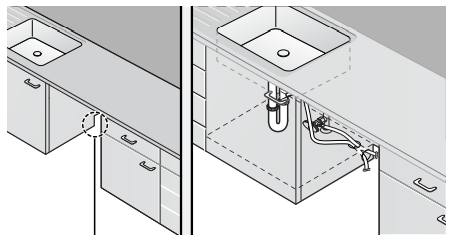

Depending on where your electrical outlet is, you may need to cut a hole in the opposite cabinet side.
Connections (Water and Electrical)

WARNING

ELECTRIC SHOCK HAZARD
Observe all local codes and ordinances for electrical and plumbing connections. All electrical and plumbing work should be performed by qualified persons. Failure to follow this warning could result in death or serious injury.
Preparing Hot Water Line Connection

IMPORTANT
The hot water supply line pressure must be between 20 psi–120 psi (0.14 MPa–0.82 MPa).
- Adjust the water heater to deliver water between 120°F (49°C)– 135°F (57.2°C). This temperature range provides the best washing result and shortest cycle time. Temperature should not exceed 135°F (57.2°C) to prevent damage to dishes.
- Turn off water supply valve.
- Seal the hot water supply line connections using Teflon tape or sealing compound to stop any water leakage.
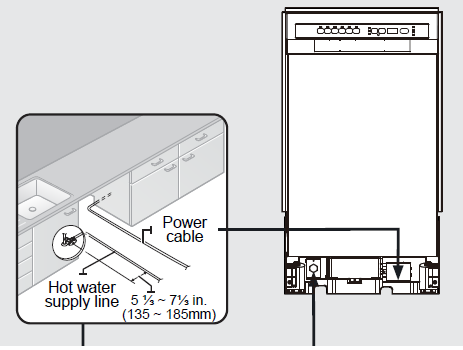
Preparing Electrical Line Connection

WARNING
ELECTRIC SHOCK HAZARD
The electrical service must conform with all state, municipal, provincial and/or local codes and ordinances and the latest edition of the National Electrical Code, or in Canada, the Canadian Electrical Code CSA C22.1 latest edition.


Direct connections require:
- The use of flexible, armored or non-metallic sheathed, copper wire with a grounding wire that meets the wiring requirements for your local codes and ordinances.
- The use of strain relief method provided with the wiring junction box or install a U.L.-listed/CSA-certified clamp connector to the wiring junction box. If using conduit, use a U.L.-listed/CSA-certified conduit connector.

Unpacking and Inspection
Unpacking the dishwasher

Unpack the dishwasher in an open area free of obstruction both around the carton and overhead. Retain the carton and all of the packing materials until the dishwasher is fully installed and operational to ensure you have removed all the product’s components from the carton prior to disposal.

ALWAYS LIFT THE DISHWASHER TO MOVE IT. Sliding it over rough surfaces can damage the dishwasher’s feet and sliding the feet over finished surfaces can, in some cases, damage that finish or the underlying surface.
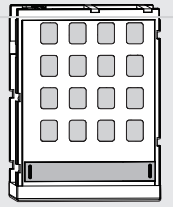
- Lift the carton up and over the dishwasher and place it on the floor.
- Place the straps and all packing materials from around the dishwasher inside the empty carton, inspecting them for any signs of damage.
- Lift the dishwasher from the carton tray, and then place it on the floor.
- Locate and set aside the dishwasher’s installation parts package and toeplate. The toeplate is attached to bottom of the carton tray. Place carton tray into the carton.

Remove toeplate and parts package from the bottom of the carton tray. - Remove the bag that protects the dishwasher during shipping.

DO NOT, under any circumstances, remove the sound-absorbent padding that surrounds the exterior of the tub of the dishwasher. - There is also packing inside the dishwasher that you may want to leave in place until the dishwasher is installed.
Inspecting the dishwasher
Mechanical inspection
- Check the plastic base assembly to ensure that it is intact.
- Check the dishwasher’s feet to ensure they are in place and can be adjusted so you can level and secure the dishwasher.
- Check all the visible components on the bottom of the dishwasher to ensure they are intact and secure.
- Check the door latch, the operation of the hinges, and confirm the door is properly secured to the dishwasher.
- Remove the two screws securing kickplate to dishwasher and remove kickplate. Set aside kickplate and screws to replace when unit is installed.
Plumbing inspection
- Check the hot water connection on the left side at the front of the base of the dishwasher. The mounting plate should be secured to the front of the base, the threads inside the connection should be smooth and shiny, and the area should be clean and free of any debris.
- Check the plastic Brake and Sensor cases to ensure these assemblies are not cracked and that all connections are secure.
- Check the drain hose for any holes or deformities that could allow a water leak during draining.
Electrical inspection
- Confirm the junction box cover is secured to the junction box on the front right-side of the base of the dishwasher.
- Confirm the electrical box was not damaged during shipping and that it is secured to the base of the dishwasher.
Visual inspection
- Confirm there are no dents or scratches on the front of the dishwasher.
- Check the edges of the doors for any roughness or cracking.
- Check the control panel to ensure it is clear and unscratched, and that all the control markers are in their proper places.
Required parts
Confirm that you have all the parts supplied by the manufacturer (see the Material and Tools section of this Installation Instruction).
Installing the Dishwasher


Disconnect electrical power at the fuse box or circuit breaker box before removing old dishwasher or beginning new installation. Failure to follow this warning could result in death or serious injury.
Verify that the circuit breaker and water supply valve are off before proceeding with the following steps.
- Make sure there are no kinks in the water hose and that it is not bent at any angles that could constrict the flow of water.
- Remove the junction box cover located at the bottom front right of the dishwasher using a screwdriver, and install the strain relief. Keep the junction box cover to replace after wiring is completed.
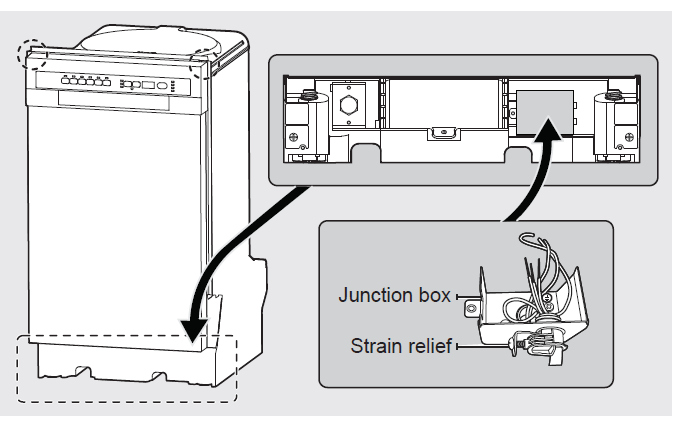
- Connect the 90° elbow joint to the inlet valve from the front of the dishwasher. Use Teflon tape or sealing compound to secure.

Do not overtighten the 90° elbow. Doing so may damage the water inlet valve and cause a water leak.
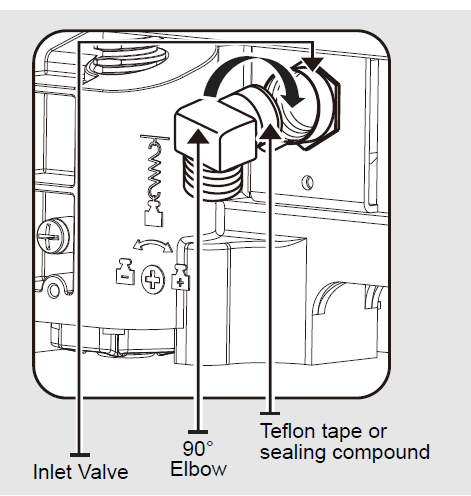
- Secure dishwasher to the countertop if the countertop is made of wood or a material that is not damaged by drilling. To attach the 2 installation brackets to the top of the dishwasher, insert each bracket tab into the corresponding slot on the top of the dishwasher. Tighten using screws ST3.5*9 provided with the unit.


- Adjust the four leveling legs at the bottom of the dishwasher after measuring the height of the cabinet opening from under the countertop to the (See Step 8, Leveling the Dishwasher.)
- Locate the hot water supply line and the power cable.
- Place the dishwasher so the power cable is in the center channel of the dishwasher base. To prevent the electrical cable from being pinched when you push the dishwasher into place, use duct tape or cable ties to secure the electrical cable to the channel.

- Pull the drain hose through the hole in the sink cabinet side wall. Keep it free of kinks.
- Make sure the hot water supply line is not twisted, and then connect the hot water supply line to the elbow joint.
- Slide the dishwasher carefully into the installation space. If possible, gently pull any excess lengths of water supply line, drain hose, or power cable back as you move the dishwasher. Get a second or third person to help you do this if necessary.


Do not place the dishwasher on the water supply line, drain hose, or power cable. Make sure none of the lines get folded or twisted during installation.

DO NOT place hands under the dishwasher when moving. Always hold under the tub not the bottom of the unit. Keep clear of sharp edges.
Leveling the Dishwasher

Dishwasher must be level for proper dish rack operation and wash performance.
- Open the door and hold level against the top of the tub to check if it is level side to side. Adjust the front legs until level.
- Remove the lower basket and place the level in the basket channel to check if it is level front to back. Adjust the rear legs until level.
- Open the door and check if the door hits the tub of the dishwasher. Adjust front leveling legs to align the door to the tub.
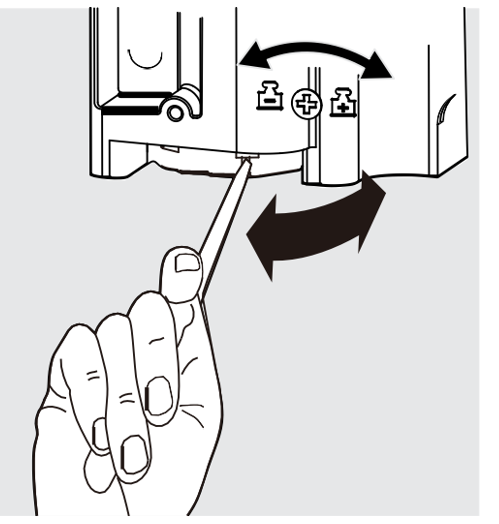

Turn leveling leg clockwise (left) to lower the leg and counterclockwise (right) to raise the leg.
Securing the Dishwasher
You must fix the dishwasher to the countertop or cabinet side walls for additional stability and safety.
If securing to the countertop (wood or other material that will not be damaged by drilling), follow the instructions below.
- Put a large towel into the bottom of the dishwasher to prevent wood shavings or a dropped screw from falling into the dishwasher.
- Verify that the installation brackets are firmly attached to the top of the unit using screws ST3.5*9 provided with the unit.
- Carefully drill screw holes into the underside of the counter top by passing the drill bit up through the screw holes in each installation bracket, making sure the diameter of the hole is smaller than the diameter of the screw.
- Insert screws ST4*14 up through the brackets, and then tighten to secure the dishwasher to the countertop.
If securing to the side cabinets (the countertop is made of granite, marble, or any other material that can be damaged by drilling), follow the instructions below.
- Put a large towel into the bottom of the dishwasher to prevent wood shavings or a dropped screw from falling into the dishwasher.
- Remove the adjustment caps with the tip of a screwdriver. The caps are just inside the tub near the middle of the tub on both sides.
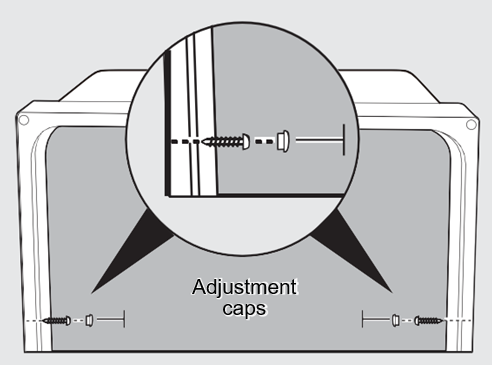
- Drill a hole into the sides of the kitchen cabinet on both sides by carefully passing a drill bit through the screw holes exposed by the removal of the spacer caps, and then drilling into the side of the cabinet. Make sure the hole you drill is smaller than the diameter of the screw and that the drill bit does not strike the sides of the spacer cap holes.
- Verify that the installation brackets are firmly attached to the side of the unit.
- Insert screws ST4*14 into the holes, and then tighten to secure the dishwasher to the cabinet.

Make sure the tub is not distorted by pressure from the screws. If the tub is distorted, loosen the screws a little. - Replace the tub adjustment caps.

- The screws or tub spacer cap may fall into the dishwasher while you are working with the door open. Cover the interior of the dishwasher with a towel to prevent any screws from falling into the dishwasher. If any foreign items such as a screw get into the dishwasher, it may cause noise, an abnormal operation, damage, or a malfunction.
- Use a magnetic screwdriver to help prevent screws from falling into the dishwasher.
- If a foreign item such as a screw gets into the dishwasher and you are unable to remove it. the dishwasher needs to be disassembled. Contact a qualified service technician for this.
Connecting the Drain Hose
- Check the parts on the sink to which the drain hose will be connected.
- There are several ways to insert the drain hose into the drain hose connector of the sink. You must connect the drain hose in accordance with the water pipe installation regulations in your region.
Connecting to drain without a garbage disposal unit with and without an air gap.
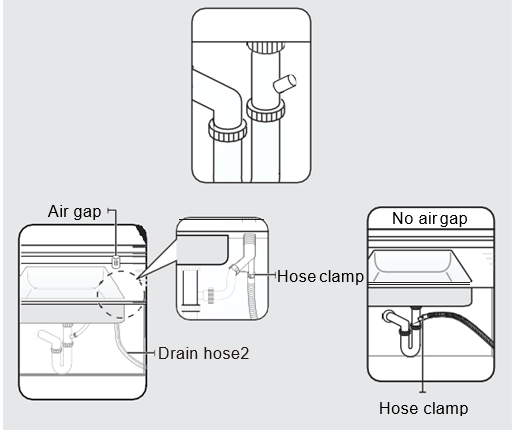
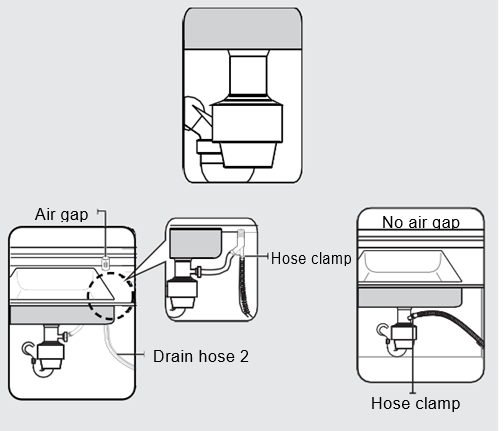
- The drain hose molded end will fit 5/8”, 3/4”, or 1” diameter connections on the air gap, waster tee, or disposer. Cut on the marked line as required for your installation.
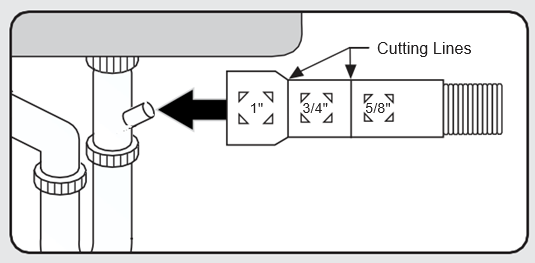

DO NOT cut corrugated portion of line. - Slide a hose clamp over the end of the drain hose. Attach the drain hose to the sink connector, slide the hose clamp to the end of the hose, and then tighten the hose clamp.

You must use a hose clamp. Failure to do so may cause water leakage. - Secure the drain hose to the sink wall using cable ties or other fastening material.
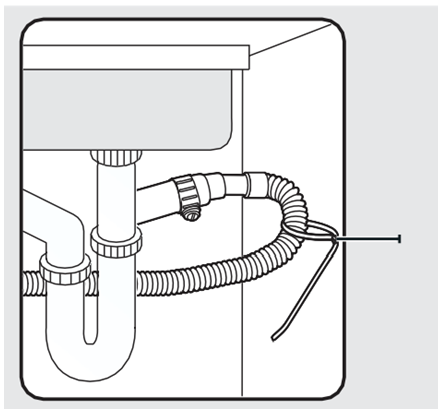
- If a longer drain hose is required, add up to 42” of length for a total of 10 ft. to the factory installed hose. Use 5/8” or 7/8” inside diameter hose and a coupler to connect the two hose ends. Secure the connection with hose clamps.
- Secure the drain hose to the air gap, waste tee, or disposer with clamps.
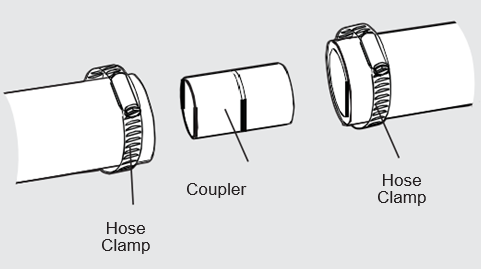
- If there is no air gap, make sure to hang the middle of the drain hose well above the sink cabinet base to prevent backflow.
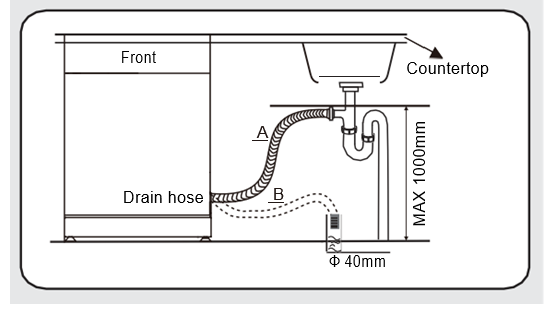

The top of the drain hose must be less than 39.3” (1000mm). - When drilling a hole for the drain hose on the cabinet wall, take caution not to damage the drain hose by sharp edges of the hole.
- On wooden walls, use sand paper to soften the edges.
- On metal walls, use insulation tape or duct tape to cover the sharp edges around the hole.

- Take caution not the damage the drain hose when installing the dishwasher on the floor, wall, or cabinet.
- Do not cut the wrinkled area of the drain hose to fit the size. When arranging the drain hose, take caution not to contact on sharp edges of the cabinet or under-sink.

- Be careful when cutting off the end of the drain hose as there is a risk of injury. Clean around the sink’s drain connection so that it does not damage the hose. Check for any foreign items in the drain hose and remove them.
- When arranging the drain hose, make sure the drain hose is not cut, torn, or broken by any sharp edges of the floor, the product itself, or the cabinet. A damaged drain hose causes a leak.

To prevent leaks or drainage problems, make sure the drain hose is not damaged, kinked, or twisted.


To avoid electrical shock, do not work on an energized circuit. Doing so could result in serious injury or death. Only qualified electricians should perform electrical work. Do not attempt any work on the dishwasher electric supply circuit until you are certain the circuit is de-energized.

WARNING
FIRE HAZARD
To avoid fire hazard, make sure electrical work is properly installed. Only qualified electricians should perform electrical work.
- Before connecting the power cable to the dishwasher, make sure the circuit breaker is OFF.
- In the junction box located at the front bottom right of the dishwasher, find the three power wires from the dishwasher including the grounding line.
- Pass the power cable through the strain relief, and then into the junction box.
- Connect the BLACK wire of the dishwasher to the BLACK wire of the power cable by inserting both into a wire nut and then rotating the wire connector.

- Connect the WHITE wire to the WHITE wire and the GREEN to the GREEN in the same manner.
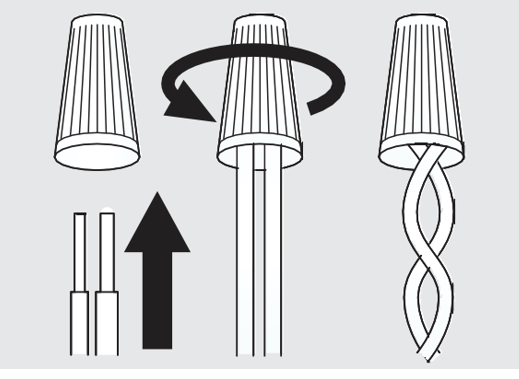
- Recheck each wire to ensure it is connected correctly and securely.

Each colored wire should be connected to the corresponding wire of the same color. WHITE should be connected to WHITE, BLACK to BLACK, and GREEN to GREEN. - Replace the junction box cover on the dishwasher.
Completing the Installation
- Open the door and remove all foam, paper packaging, and unnecessary parts.
- Turn the circuit breaker ON.
- Open the water supply valve to supply water to the dishwasher.
- Turn on the dishwasher, and then select and run a cycle.

Make sure to check for water leakage on both ends of the water supply line and drain hose connector.

Check that the power turns on correctly and that there is NO water leakage while the dishwasher is operating.- If no errors occur while it is operating, turn OFF the dishwasher, and then install the kickplate.
- If an error has occurred, turn off the dishwasher, close the water supply valve, and refer to the user manual or contact local service center.
- Insert the black adjustable toeplate under the kickplate and install onto the unit. Make sure the top kickplate wiper edge is located at the bottom of the kickplate and that the edge of the adjustable toeplate reaches to the floor. Secure with the two kickplate screws previously removed (ST3.9*13).
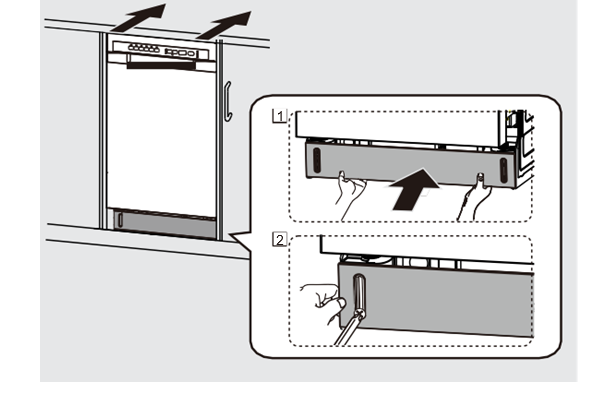
Specifications
| Capacity | 8 place settings |
| Dimensions | 17.6 x 22.6 x 32.4 inches 450 x 575 x 825 mm
(W x D x H) |
| Power Supply | 120v, 60Hz |
| Rated Power Usage | wash motor 100W, heater 700W |
| Water feed pressure | 20 psi–120 psi
(0.14 MPa–0.82 MPa) |
